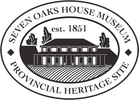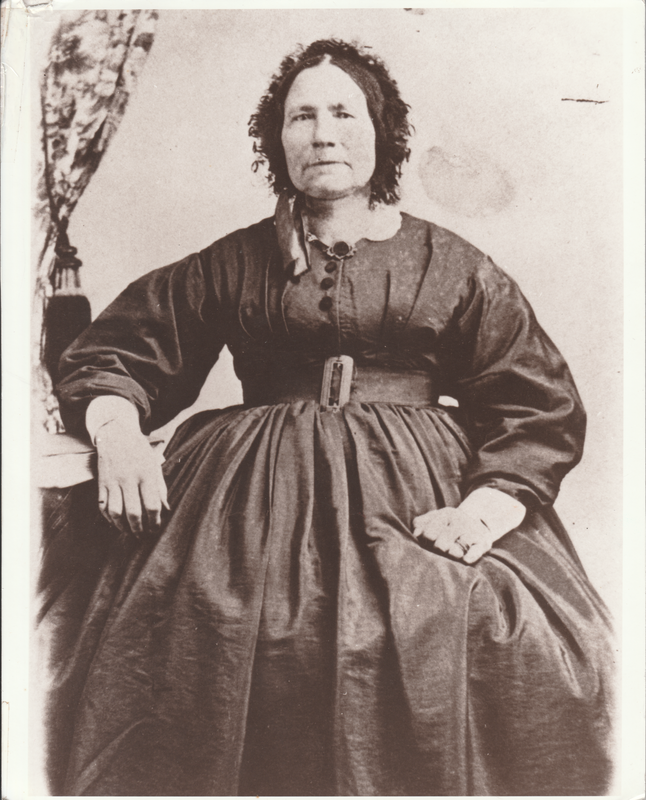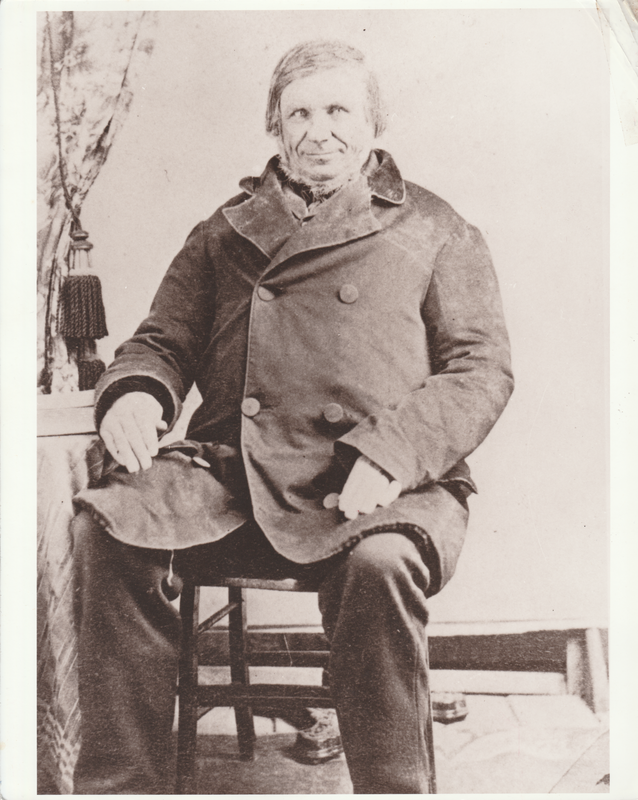Mary Sinclair Inkster
|
In many ways, John Inkster was marrying into Red River royalty: Mary grew up immersed in the fur trade, while her language skills and family connections opened doors for her recently-immigrated husband. Her father had virtually controlled trade to and from Europe, as the Chief Factor at York Factory. Her brother, Thomas Sinclair, was a prominent leader in the Anglo-Metis community. He worked closely with Louis Riel Sr and Andrew Bannatyne to break the HBC's monopoly on trade.
Sources mention that Mary taught settler women "the Indian language", which probably meant Cree and/or Bungee (a local trade language). Her son Colin wrote that she had a remarkable head for business, and that she was responsible for keeping the family's account books. Oral history from another descendant states that she was responsible for running the family's businesses, and that she could calculate a page of accounts as quickly as an average person could read it.
Her son, George Inkster, later made the improbable claim that Mary was "closely-related to the last Earl of the Orkney Islands". He said his earliest memory was of John Inkster telling the children that they were descended from the medieval Vikings who conquered the Orkney Islands from the Scots. Several Earls of Orkney during the 1400s were named Sinclair.
Mary died in 1892 at the age of 88, and was buried in St. John’s Cathedral cemetery.
Sources mention that Mary taught settler women "the Indian language", which probably meant Cree and/or Bungee (a local trade language). Her son Colin wrote that she had a remarkable head for business, and that she was responsible for keeping the family's account books. Oral history from another descendant states that she was responsible for running the family's businesses, and that she could calculate a page of accounts as quickly as an average person could read it.
Her son, George Inkster, later made the improbable claim that Mary was "closely-related to the last Earl of the Orkney Islands". He said his earliest memory was of John Inkster telling the children that they were descended from the medieval Vikings who conquered the Orkney Islands from the Scots. Several Earls of Orkney during the 1400s were named Sinclair.
Mary died in 1892 at the age of 88, and was buried in St. John’s Cathedral cemetery.
John Inkster
|
By 1823 John was working as a Labourer for the Hudson’s Bay Company in the Upper Red River District. He had passed through Oxford House en route to the settlement, and this may be where John and Mary met.
In 1824 John settled at the Upper Red River Settlement. By 1827 the Inksters' homestead was well established. Census records show that they were cultivating 6 acres of land and owned a house, a stable, a canoe, a plow and harrow, 2 cows, 2 oxen, and 5 calves. Their first homestead is though to be located north of Seven Oaks, near the St. Andrew's area.
Around 1831 John & Mary re-settled at Seven Oaks with his uncle, James Inkster. James Inkster was an HBC servant who had served at Fort Albany on James Bay as well as Brandon House in the role of Cooper, Boatbuilder, and Carpenter before retiring to Upper Red River. Uncle James married Mary, a Cree woman on October 26, 1824. John was later known by the nickname Orkney Johnnie to distinguish him from his uncle's Metis son, also named John Inkster, who was called Indian Johnnie.
At this time they built a simple two-room log cabin in the Red River Frame style, which still stands today as the oldest building in Winnipeg.
On April 30, 1835 John received a land grant from the HBC to Lot #215 (converted to Lot #6 of the Dominion Land Survey). This totaled 291.06 acres of property, including part of Lot #216, the land owned by his uncle James. It appears that John farmed or leased a portion of his uncle's lot, before purchasing it alongside his own.
The Inksters began operating a windmill in the 1830s, and John used his contacts within the HBC to develop an extensive freighting business. He brought imported goods into the Settlement from the United States, Scotland, England, and distant eastern Canada. The family prospered and became one of the wealthiest in the area.
In 1851 construction began on Seven Oaks House. Once this imposing new home was complete in 1853, the family's original two-room cottage was converted into a kitchen, general store and community post office.
In 1856 John became president of Steam Mill Company, which brought components for a sawmill down-river by barge to be set up at Redwood. A fire destroyed the mill under mysterious circumstances in 1860. In 1862 the Inksters built a new water mill along Main Street. Newspaper reports noted the mill dam was “perhaps the most substantial in the country”, and remnants could still be seen as late as 1926.
John also served a variety of public roles. He was appointed to the local government, the Council of Assiniboia in 1857, and held this position until 1868. He was a warden of St. John's Cathedral and worked as one of the first teachers in the Settlement. From 1850 - 1858 John served as a magistrate for the Lower District at a salary of £5 per year, and he became the auditor of public accounts in 1863.
He was asked to represent the community of St. John's during the 1869-70 Red River Rebellion, but he was too ill to participate.
John Inkster died June 30, 1875 at the age of 75 and was buried in St. John’s Cathedral cemetery.
In 1824 John settled at the Upper Red River Settlement. By 1827 the Inksters' homestead was well established. Census records show that they were cultivating 6 acres of land and owned a house, a stable, a canoe, a plow and harrow, 2 cows, 2 oxen, and 5 calves. Their first homestead is though to be located north of Seven Oaks, near the St. Andrew's area.
Around 1831 John & Mary re-settled at Seven Oaks with his uncle, James Inkster. James Inkster was an HBC servant who had served at Fort Albany on James Bay as well as Brandon House in the role of Cooper, Boatbuilder, and Carpenter before retiring to Upper Red River. Uncle James married Mary, a Cree woman on October 26, 1824. John was later known by the nickname Orkney Johnnie to distinguish him from his uncle's Metis son, also named John Inkster, who was called Indian Johnnie.
At this time they built a simple two-room log cabin in the Red River Frame style, which still stands today as the oldest building in Winnipeg.
On April 30, 1835 John received a land grant from the HBC to Lot #215 (converted to Lot #6 of the Dominion Land Survey). This totaled 291.06 acres of property, including part of Lot #216, the land owned by his uncle James. It appears that John farmed or leased a portion of his uncle's lot, before purchasing it alongside his own.
The Inksters began operating a windmill in the 1830s, and John used his contacts within the HBC to develop an extensive freighting business. He brought imported goods into the Settlement from the United States, Scotland, England, and distant eastern Canada. The family prospered and became one of the wealthiest in the area.
In 1851 construction began on Seven Oaks House. Once this imposing new home was complete in 1853, the family's original two-room cottage was converted into a kitchen, general store and community post office.
In 1856 John became president of Steam Mill Company, which brought components for a sawmill down-river by barge to be set up at Redwood. A fire destroyed the mill under mysterious circumstances in 1860. In 1862 the Inksters built a new water mill along Main Street. Newspaper reports noted the mill dam was “perhaps the most substantial in the country”, and remnants could still be seen as late as 1926.
John also served a variety of public roles. He was appointed to the local government, the Council of Assiniboia in 1857, and held this position until 1868. He was a warden of St. John's Cathedral and worked as one of the first teachers in the Settlement. From 1850 - 1858 John served as a magistrate for the Lower District at a salary of £5 per year, and he became the auditor of public accounts in 1863.
He was asked to represent the community of St. John's during the 1869-70 Red River Rebellion, but he was too ill to participate.
John Inkster died June 30, 1875 at the age of 75 and was buried in St. John’s Cathedral cemetery.






